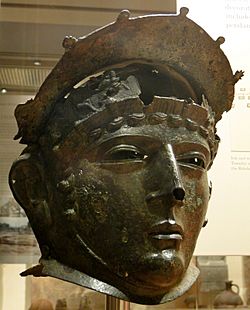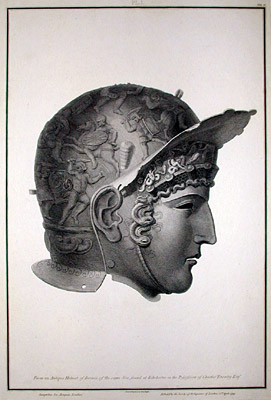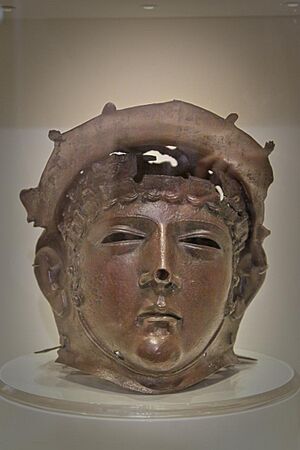Ribchester Helmet facts for kids
Quick facts for kids Ribchester Helmet |
|
|---|---|

On display in the British Museum
|
|
| Material | Bronze |
| Size | Height: 276 mm Weight: 1305.6 g |
| Created | Roman, late 1st to early 2nd century AD |
| Discovered | By son of Joseph Walton, clogmaker, in 1796 |
| Place | Ribchester, Lancashire |
| Present location | Room 49, British Museum, London |
| Registration | 1814,0705.1 |
The Ribchester Helmet is a special Roman helmet made of bronze. It's very old, from around 100 to 200 AD. Today, you can see it at the British Museum in London. This helmet was found in 1796 in a place called Ribchester, in Lancashire, England. It was part of a group of treasures known as the Ribchester Hoard. A small statue of a sphinx was thought to have been attached to the helmet, but it got lost.
What is the Ribchester Helmet?
This helmet was not made for fighting in battles. It was too fancy and not strong enough to protect a soldier. Instead, it was used for special shows of horse riding. These shows were called hippika gymnasia, which means cavalry sports. Soldiers would show off their riding skills while wearing these amazing helmets.
How Was the Helmet Found?

The Ribchester Helmet was found in the summer of 1796. A boy, whose father Joseph Walton was a clogmaker, discovered it. The boy found the helmet and other items buried in a hollow. It was about three meters deep, near a road in Ribchester. The spot was also close to a river.
People think the treasures were stored in a wooden box. The helmet was the largest item found. Other things in the Ribchester Hoard included bowls, pieces of a vase, and a small statue of Minerva. There were also parts of basins, plates, and other items. These items were thought to have been used for religious purposes. The sand covering them helped keep them safe for a long time.
A man named Charles Townley bought the helmet and other items from Joseph Walton. Townley was a famous collector of Roman art. He lived nearby at Towneley Hall. Townley wrote a detailed letter about the discovery. This letter was sent to the Society of Antiquaries of London. After Townley died in 1805, his cousin, Peregrine Edward Towneley, inherited his collection. The British Museum bought the helmet and the rest of the collection in 1814.
There was also a bronze statue of a sphinx found with the hoard. But this sphinx was lost. Walton gave it to his brother's children to play with. A person who studied the hoard, Thomas Dunham Whitaker, thought the sphinx might have been attached to the helmet. It had a curved base that fit the helmet's shape. Traces of solder, which is used to join metal, were also found on it. This idea became more likely when the Crosby Garrett Helmet was found in 2010. That helmet had a winged griffin attached to it.
Why is This Helmet Important?
Only three Roman helmets that cover the face have been found in Britain. Before the Crosby Garrett Helmet was found in 2010, and the Newstead Helmet in 1905, the Ribchester Helmet was considered the best one. The Ribchester helmet was found rusted but mostly complete. The Newstead helmet was also largely complete. However, the Crosby Garrett helmet was found in 67 pieces!
We know these helmets were used for displays because of writings by Arrian of Nicomedia. He was a governor during the time of Emperor Hadrian. Arrian wrote that high-ranking soldiers or those with special skills could wear these helmets. They wore them during the hippika gymnasia, which were cavalry tournaments.
The Ribchester Helmet was voted Britain's "second best Roman find." This was in a poll on a website for the TV show Time Team. The Vindolanda tablets were voted the best.


